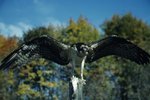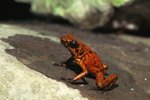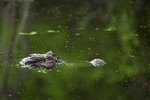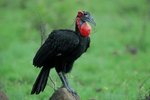
Florida's Everglades contains numerous distinct habitats, including tropical hardwood forest, dry prairies, swamps and marshes, grasslands and pine savannas. In this huge ecosystem dwell thousands of different types of plants, animals and insects. Some of these species are threatened or endangered, primarily because of development and human activity. Federal, state and local governments, along with private organizations, are trying to save the habitat of the rarest animals.
Manatee
Trichechus manatus laterostris, the West Indian manatee, might be one of the Sunshine State's best-known animals, but this slow, large aquatic mammal is also endangered. Manatees require warm water temperatures exceeding 63 degrees Fahrenheit. Many fall prey to boats, personal watercraft and the like. These gentle creatures, favorites of tourists, subsist on aquatic plants but sometimes consume fish. According to the National Park Service, fewer than 1,900 manatees now live in Florida.
Florida Panther
Felis concolor coryi, the Florida panther, is the rarest of the large mammals inhabiting the Everglades. There are fewer than 100 of these big cats still roaming the hardwood hammocks of the Everglades, areas of tropical forest in the higher elevations. Habitat degradation isn't the sole cause of the panther's rarity -- many have been hit by motor vehicles. The United States Army Corps of Engineers, working in partnership with state and local organizations, is attempting to save the panther using methods such as radio tracking and adding other types of panthers for gene pool increase.
Birds
Rostrhamus sociabilis plumbeus, snail kites, eat only apple snails. The National Wildlife Refuge estimates the numbers of these hawks in the Everglades at between 400 and 500 breeding pairs. Aphelocoma coerulescens, the Florida scrub jay, is losing habitat to development. The NWR says only about 3,000 of these blue and white songbirds remain in the Everglades. While the Caracara cheriway, the crested caracara, is related to falcons, it doesn't fly quickly. Named for the sound it makes, these large bird primarily feast on carrion, although they do hunt small mammals, fish and reptiles. Ammodramus maritimus mirabilis, the Cape Sable seaside sparrow, matures only 5 inches in length. This little bird lives in the Everglades' subtropical marshes. Habitat destruction, including that by hurricanes, has caused sparrow numbers to decline. Other rare birds in the Everglades include haradrius melodus, the piping plover; Picoides borealis, the red-cockaded woodpecker; Sterna dougallii, the roseate tern, and Haliaeetus leucocephalus, the bald eagle.
Sea Turtles
Threatened or endangered sea turtles living in the Everglades include Chelonia mydas, the green sea turtle, Eretmochelys imbricata, the hawksbill sea turtle, Dermochelys coriacea, the loggerhead sea turtle and Lepidochelys kempii, the Atlantic Ridley sea turtle. Turtle decline results from commercial turtle egg harvesting and incidental catching by the fish and shrimp industry.
References
- Florida Museum of Natural History: Everglades -- Threatened and Endangered Species
- U.S. Army Corps of Engineers: So You Want to Know More About ... Plants and Animals of the Everglades
- Friends of the Everglades: Threatened Species
- National Wildlife Refuge Association: Everglades
- National Park Service: West Indian Manatee -- Species Profile
Photo Credits
-
Photos.com/Photos.com/Getty Images
Writer Bio
Jane Meggitt has been a writer for more than 20 years. In addition to reporting for a major newspaper chain, she has been published in "Horse News," "Suburban Classic," "Hoof Beats," "Equine Journal" and other publications. She has a Bachelor of Arts in English from New York University and an Associate of Arts from the American Academy of Dramatics Arts, New York City.




